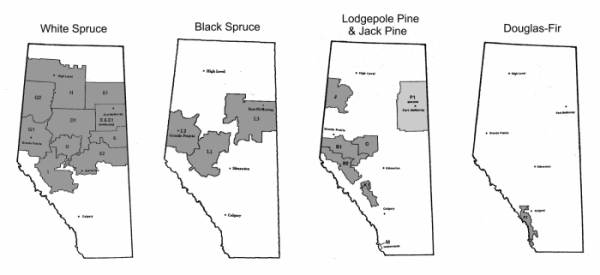7. Policies, practices & what you can do
A comprehensive framework for collection, storage, handling, and deployment of seed and vegetative propagules were first released in 2003 as Standards for Tree Improvement in Alberta (STIA). This document has recently been updated and is now referred to as the Alberta Forest Genetic Resource Management and Conservation Standards (FGRMS). Understanding and following these guidelines will ensure that planting stock is well adapted to the planting site, resulting in optimum productivity and forest health.
As previously mentioned, there are two main sets of regulations governing collection, handling, and deployment of genetic materials for reforestation on public lands. Collections of seed or vegetative propagules from natural stands are referred to as Stream 1 material. The standards explain how this material needs to be registered, stored, propagated, and deployed. The Alberta seed zone system is used to ensure that planting stock is well adapted by planting Stream 1 material within the same seedzone from which it was collected.
As a practitioner, you can ensure successful plantation establishment and release from reforestation obligations by making sure that appropriate collections of tree seed for your management unit are available.
As an alternative to collections from natural stands, Alberta Sustainable Resource Development recommends the use of genetically improved planting stock known as Stream 2 material. This material undergoes selection and/or breeding, with a known pedigree of individuals. In Alberta, this is called Controlled Parentage Program (CPP) and involves testing of selections or progeny for adaptation across multiple sites (3 test sites if provenances come from within the CPP region and 5 test sites if they were transferred from outside the CPP region boundaries). In addition to being well adapted, Stream 2 material is also selected for superior growth and/or disease resistance.
Using Stream 2 material has many potential advantages not only with respect to productivity but also to maximize the adaptability of populations to changing climate. At the moment, there are 24 controlled parental programs, with approximately half of them operational as of 2009.
As previously mentioned, there are two main sets of regulations governing collection, handling, and deployment of genetic materials for reforestation on public lands. Collections of seed or vegetative propagules from natural stands are referred to as Stream 1 material. The standards explain how this material needs to be registered, stored, propagated, and deployed. The Alberta seed zone system is used to ensure that planting stock is well adapted by planting Stream 1 material within the same seedzone from which it was collected.
As a practitioner, you can ensure successful plantation establishment and release from reforestation obligations by making sure that appropriate collections of tree seed for your management unit are available.
As an alternative to collections from natural stands, Alberta Sustainable Resource Development recommends the use of genetically improved planting stock known as Stream 2 material. This material undergoes selection and/or breeding, with a known pedigree of individuals. In Alberta, this is called Controlled Parentage Program (CPP) and involves testing of selections or progeny for adaptation across multiple sites (3 test sites if provenances come from within the CPP region and 5 test sites if they were transferred from outside the CPP region boundaries). In addition to being well adapted, Stream 2 material is also selected for superior growth and/or disease resistance.
Using Stream 2 material has many potential advantages not only with respect to productivity but also to maximize the adaptability of populations to changing climate. At the moment, there are 24 controlled parental programs, with approximately half of them operational as of 2009.
